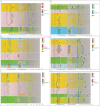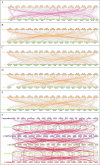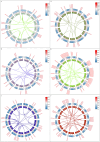Genome-wide identification of GATA family genes in sweet potato (Ipomoea batatas L.) and their expression patterns under abiotic stress
- PMID: 40772271
- PMCID: PMC12326740
- DOI: 10.3389/fgene.2025.1635749
Genome-wide identification of GATA family genes in sweet potato (Ipomoea batatas L.) and their expression patterns under abiotic stress
Abstract
GATAs, a type of zinc finger protein transcription factors, can bind to DNA regulatory regions to control the expression of target genes, thereby affecting plant growth and development under normal conditions or environmental stress. However, the GATA gene family has not been identified in sweet potato. In this study, a total of 35, 33, 34, 39, 63, and 56 GATA genes were identified in sweet potato, Ipomoea aquatica, Ipomoea cairica, Ipomoea nil, Ipomoea triloba, and Ipomoea trifida, respectively. Phylogenetic analysis categorized the GATA genes into six groups according to their distinct features, and this classification was validated by the structural characteristics of exons/introns and conserved motif analysis. The cis-acting elements located in the promoter regions were also found to be enriched with biotic and abiotic responsive elements, which may play a pivotal role in plant stress adaptation. Then the gene duplication events and synteny between the genome of sweet potato and those of Ipomoea aquatica, Ipomoea cairica, Ipomoea nil, Ipomoea triloba, and Ipomoea trifida were analyzed, which provided insights into evolutionary mechanisms. Moreover, expression pattern analysis was performed on IbGATA genes, many of which were significantly induced by multiple types of abiotic stress, which may render these genes candidates for molecular breeding strategies in sweet potato. Overall, this experiment conducted a systematic exploration of GATA genes by investigating their evolutionary relationships, structural characteristics, functional properties, and expression patterns, thereby establishing a theoretical foundation for further in-depth research on the features of the GATA gene family.
Keywords: GATA transcription factor; abiotic stress; drought and salt stress; genome-wide; sweet potato (Ipomoea batatas L.).
Copyright © 2025 Wang, Lan, Xiao, Peng, Pan, Deng and Wu.
Conflict of interest statement
The authors declare that the research was conducted in the absence of any commercial or financial relationships that could be construed as a potential conflict of interest.
Figures







Similar articles
-
Genome-Wide Identification and Expression Analysis of the Fructose-1,6-Bisphosphate Aldolase (FBA) Gene Family in Sweet Potato and Its Two Diploid Relatives.Int J Mol Sci. 2025 Jul 30;26(15):7348. doi: 10.3390/ijms26157348. Int J Mol Sci. 2025. PMID: 40806478 Free PMC article.
-
Comparative analysis of the LEA gene family in seven Ipomoea species, focuses on sweet potato (Ipomoea batatas L.).BMC Plant Biol. 2024 Dec 26;24(1):1256. doi: 10.1186/s12870-024-05981-x. BMC Plant Biol. 2024. PMID: 39725899 Free PMC article.
-
Genome-wide identification and characterization of the CCT gene family in Chinese cabbage (Brassica rapa) response to abiotic stress.BMC Genomics. 2025 Jul 1;26(1):593. doi: 10.1186/s12864-025-11768-7. BMC Genomics. 2025. PMID: 40597573 Free PMC article.
-
Potential Effects of Sweet Potato (Ipomoea batatas) in Hyperglycemia and Dyslipidemia-A Systematic Review in Diabetic Retinopathy Context.Int J Mol Sci. 2021 Oct 6;22(19):10816. doi: 10.3390/ijms221910816. Int J Mol Sci. 2021. PMID: 34639164 Free PMC article.
-
Systemic treatments for metastatic cutaneous melanoma.Cochrane Database Syst Rev. 2018 Feb 6;2(2):CD011123. doi: 10.1002/14651858.CD011123.pub2. Cochrane Database Syst Rev. 2018. PMID: 29405038 Free PMC article.
References
-
- Chen C., Zhang K. X., Khurshid M., Li J. B., He M., Georgiev M. I., et al. (2019). MYB transcription repressors regulate plant secondary metabolism. Crit. Rev. Plant Sci. 38 (3), 159–170. 10.1080/07352689.2019.1632542 - DOI
-
- Chen F., Hu Y., Vannozzi A., Wu K. C., Cai H. Y., Qin Y., et al. (2018). The WRKY transcription factor family in model plants and crops. Crit. Rev. Plant Sci. 36 (5-6), 311–335. 10.1080/07352689.2018.1441103 - DOI
LinkOut - more resources
Full Text Sources

